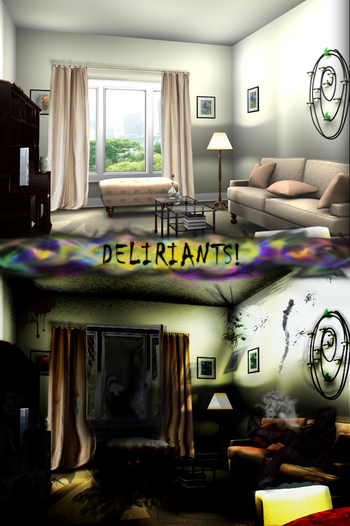Deliriant
Deliriants are a class of hallucinogen that are unique in that, even with lower doses, they offer solid hallucinations which display themselves seamlessly into waking consciousness, similar to fully formed dreams or delusions. In contrast, classical psychedelics and dissociatives have progressive levels of multiple all-encompassing sensory effects before reaching the level of concrete hallucination.

The term deliriant was introduced by David F. Duncan and Robert S. Gold to distinguish these drugs from psychedelics and dissociatives such as LSD and ketamine respectively, due to their primary effect of causing delirium, as opposed to the more lucid states produced by other types of hallucinogen.[1] The term is generally used to refer to anticholinergic drugs.
Despite the fully legal status of several common deliriant plants, substances which fall under this class are largely unpopular as recreational drugs due to the severe and unpleasant nature of the hallucinations produced.[2] In addition to their potentially dangerous mental effects (accidents during deliriant experiences are common)[3] Certain deliriants are poisonous and can cause death due to tachycardia-induced heart failure and hyperthermia even in small doses.[4]
Method of action
Deliriants work via their antagonistic action on acetylcholine receptors. Inhibition of acetylcholine leads to decreased levels of acetylcholine, causing delirium, sedation and intensely realistic hallucinations. In contrast, cannabis and caffeine have a reverse effect by inhibiting acetylcholine esterate, which breaks down acetylcholine. This leads to increased levels of acetylcholine and improved cognition and stimulation; thus cannabis has an inhibitory effect on deliriants.
Subjective effects
The effects listed below are based upon the subjective effects index and personal experiences of PsychonautWiki contributors. The listed effects will rarely if ever occur all at once but heavier dosages will increase the chances and are more likely to induce a full range of effects.
Visual effects
Suppression
Distortions
Hallucinatory states
- External hallucinations (Autonomous entities, Settings, sceneries, and landscapes, Alterations in perspective and Scenarios and plots) - In comparison to other classes of hallucinogen, this effect occurs more frequently than that of any other at moderate to heavy dosages and is the defining feature of the experience. It can be comprehensively described through its variations as delirious in believability, autonomous in controllability and solid in style. The most common themes for these hallucinations include those of both everyday occurrences such as smoking phantom cigarettes, talking to people who are not there, insects and sinister, nightmarish experiences.
- Internal hallucinations (Autonomous entities, Settings, Alterations in perspective and Scenarios) - In comparison to other classes of hallucinogen, this effect occurs briefly and spontaneously at moderate dosages but becomes progressively extended in its occurrence and duration proportional to dosage before eventually becoming all encompassing. It can be comprehensively described through its variations as delirious in believability, interactive in style, equal in new experiences and memory replays in content, autonomous in controllability and solid in style.
Cognitive effects
- Anxiety
- Temporary depression
- Thought deceleration
- Amnesia
- Suppression of vocabulary
- Delusions
- Thought loops
- Direct communication with the subconscious
- Ego suppression, loss and death
Auditory effects
Pharmacological classes
A-typical
Plants and Entheogens
History
The employment of deliriants for shamanic purposes through the famed Datura plant has been in use since before recorded history. Chinese, Aztec, Indian, Native American, Caribbean Island, Chumash, Gypsy, Mexican, South American and Zuni records and legends all mention the use of datura leaves for sacred rituals and visionary purposes. Datura was used as a spiritual tool and a rite of passage.
References
- ↑ Duncan, D. F., and Gold, R. S. (1982). Drugs and the Whole Person. New York: John Wiley & Sons
- ↑ Grinspoon, Lester and Bakalar, James B. (1997). Psychedelic Drugs Reconsidered. The Lindesmith Center
- ↑ Datura Items | http://www.lycaeum.org/mv/mu/datura.html
- ↑ Kathleen M Beaver, Thomas J Gavin, Treatment of acute anticholinergic poisoning with physostigmine, The American Journal of Emergency Medicine, Volume 16, Issue 5, September 1998, Pages 505-507, ISSN 0735-6757, 10.1016/S0735-6757(98)90003-1. | http://www.sciencedirect.com/science/article/pii/S0735675798900031